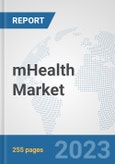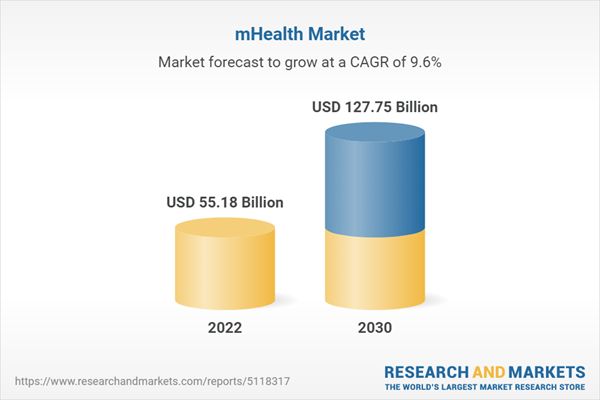The report on the global mhealth market provides qualitative and quantitative analysis for the period from 2021-2030. The global mhealth market was valued at USD 55.18 billion in 2022 and is expected to reach USD 127.75 billion in 2030, with a CAGR of 9.58% during the forecast period 2023-2030. The study on mhealth market covers the analysis of the leading geographies such as North America, Europe, Asia Pacific, and RoW for the period of 2021-2030.
mHealth is a rapidly evolving field of healthcare that leverages mobile devices, such as smartphones and tablets, to support medical and public health practices. It encompasses a wide range of applications, including remote patient monitoring, health information dissemination, diagnostic support, and even treatment delivery, all through mobile apps and wireless technologies. Additionally, the scope of mHealth is its ability to improve healthcare access and delivery in remote or underserved areas. Mobile health solutions enable healthcare professionals to reach patients in remote locations where access to traditional healthcare facilities may be limited. Telemedicine, a key component of mHealth, allows for virtual consultations and medical advice, breaking down geographical barriers. Moreover, mHealth can facilitate health education and awareness through text messages, apps, and multimedia content, empowering individuals in remote regions with valuable health information.
The rising demand for remote healthcare and telemedicine services is a key driver of the mHealth market, as it enables convenient access to medical consultations and monitoring, especially in underserved or remote areas, contributing to the industry's rapid growth. Additionally, government initiatives and regulations are bolstering the mobile health solutions market by fostering an environment of trust, standardization, and interoperability. These measures encourage the development and adoption of mHealth technologies, ensuring patient data security and promoting innovation in healthcare delivery. However, data privacy and security concerns are impeding the widespread adoption of mHealth solutions. Patients and healthcare providers worry about the protection of sensitive health information, hindering trust in these technologies. Addressing these concerns through robust encryption and regulatory compliance is crucial to unlocking mHealth's full potential. Although, the growing utilization of wearable devices and smartphone apps offers a substantial growth opportunity for the mHealth market. These technologies enable users to track and manage their health conveniently, promoting preventive care and patient engagement, which can drive the market's expansion and improve overall healthcare outcomes.
North America holds the largest market share in the mHealth (mobile Health) market, primarily driven by robust healthcare infrastructure, widespread smartphone adoption, and substantial investments in healthcare technology. The United States, in particular, played a pivotal role, with a surge in telemedicine and remote patient monitoring services, especially during the COVID-19 pandemic. The region's mature regulatory environment also encouraged the development and adoption of mHealth solutions. Moreover, the fastest-growing region, Asia-Pacific showed remarkable potential and is anticipated to experience rapid growth in the mHealth market. Factors contributing to this growth included the region's immense population, increasing smartphone penetration, rising healthcare awareness, and the adoption of digital health technologies in countries such as China and India. Additionally, governments in these countries were actively promoting digital healthcare initiatives, further propelling the mHealth sector's expansion.
1. Key Opinion Leaders
2. Internal and External subject matter experts
3. Professionals and participants from the industry
2. Product/brand/marketing managers
3. CXO level executives
4. Regional/zonal/ country managers
5. Vice President level executives.
2. Government/institutional publications
3. Trade and associations journals
4. Databases such as WTO, OECD, World Bank, and among others.
5. Websites and publications by research agencies
2. Complete coverage of all the segments in the mhealth market to analyze the trends, developments in the global market and forecast of market size up to 2030.
3. Comprehensive analysis of the companies operating in the global mhealth market. The company profile includes analysis of product portfolio, revenue, SWOT analysis and latest developments of the company.
4. Growth Matrix presents an analysis of the product segments and geographies that market players should focus to invest, consolidate, expand and/or diversify.
mHealth is a rapidly evolving field of healthcare that leverages mobile devices, such as smartphones and tablets, to support medical and public health practices. It encompasses a wide range of applications, including remote patient monitoring, health information dissemination, diagnostic support, and even treatment delivery, all through mobile apps and wireless technologies. Additionally, the scope of mHealth is its ability to improve healthcare access and delivery in remote or underserved areas. Mobile health solutions enable healthcare professionals to reach patients in remote locations where access to traditional healthcare facilities may be limited. Telemedicine, a key component of mHealth, allows for virtual consultations and medical advice, breaking down geographical barriers. Moreover, mHealth can facilitate health education and awareness through text messages, apps, and multimedia content, empowering individuals in remote regions with valuable health information.
The rising demand for remote healthcare and telemedicine services is a key driver of the mHealth market, as it enables convenient access to medical consultations and monitoring, especially in underserved or remote areas, contributing to the industry's rapid growth. Additionally, government initiatives and regulations are bolstering the mobile health solutions market by fostering an environment of trust, standardization, and interoperability. These measures encourage the development and adoption of mHealth technologies, ensuring patient data security and promoting innovation in healthcare delivery. However, data privacy and security concerns are impeding the widespread adoption of mHealth solutions. Patients and healthcare providers worry about the protection of sensitive health information, hindering trust in these technologies. Addressing these concerns through robust encryption and regulatory compliance is crucial to unlocking mHealth's full potential. Although, the growing utilization of wearable devices and smartphone apps offers a substantial growth opportunity for the mHealth market. These technologies enable users to track and manage their health conveniently, promoting preventive care and patient engagement, which can drive the market's expansion and improve overall healthcare outcomes.
North America holds the largest market share in the mHealth (mobile Health) market, primarily driven by robust healthcare infrastructure, widespread smartphone adoption, and substantial investments in healthcare technology. The United States, in particular, played a pivotal role, with a surge in telemedicine and remote patient monitoring services, especially during the COVID-19 pandemic. The region's mature regulatory environment also encouraged the development and adoption of mHealth solutions. Moreover, the fastest-growing region, Asia-Pacific showed remarkable potential and is anticipated to experience rapid growth in the mHealth market. Factors contributing to this growth included the region's immense population, increasing smartphone penetration, rising healthcare awareness, and the adoption of digital health technologies in countries such as China and India. Additionally, governments in these countries were actively promoting digital healthcare initiatives, further propelling the mHealth sector's expansion.
Report Findings
1) Drivers
- Increasing demand for remote healthcare services and telemedicine is driving the mhealth market.
- Government initiatives and regulations promoting mobile health solutions market.
2) Restraints
- Data privacy and security concerns are hampering the widespread adoption of mhealth solutions.
3) Opportunities
- The expanding use of wearable devices and smartphone applications presents a significant opportunity for the mhealth market's expansion.
Research Methodology
A) Primary Research
The primary research involves extensive interviews and analysis of the opinions provided by the primary respondents. The primary research starts with identifying and approaching the primary respondents, the primary respondents are approached include1. Key Opinion Leaders
2. Internal and External subject matter experts
3. Professionals and participants from the industry
The primary research respondents typically include
1. Executives working with leading companies in the market under review2. Product/brand/marketing managers
3. CXO level executives
4. Regional/zonal/ country managers
5. Vice President level executives.
B) Secondary Research
Secondary research involves extensive exploring through the secondary sources of information available in both the public domain and paid sources. Each research study is based on over 500 hours of secondary research accompanied by primary research. The information obtained through the secondary sources is validated through the crosscheck on various data sources.The secondary sources of the data typically include
1. Company reports and publications2. Government/institutional publications
3. Trade and associations journals
4. Databases such as WTO, OECD, World Bank, and among others.
5. Websites and publications by research agencies
Segment Covered
The global mhealth market is segmented on the basis of category, service type, and service provider.The Global mHealth Market by Category
- Apps- Disease & Treatment Management
- Wellness Management
- Wearable- Body & Temperature Monitors
- Glucose Monitors
The Global mHealth Market by Service Type
- Monitoring Services
- Diagnostic Services
- Treatment Services
- Others
The Global mHealth Market by Service Provider
- mHealth App Companies
- Hospitals
- Health Insurance
Company Profiles
The companies covered in the report include- Apple Inc.
- VertMarkets, Inc.
- Veradigm LLC
- Orange Business
- Google LLC
- AirStrip Technologies, Inc
- Qualcomm Technologies, Inc.
- Telefónica S.A.
- Vodafone Group
- Samsung Electronics Co., Ltd.
What does this Report Deliver?
1. Comprehensive analysis of the global as well as regional markets of the mhealth market.2. Complete coverage of all the segments in the mhealth market to analyze the trends, developments in the global market and forecast of market size up to 2030.
3. Comprehensive analysis of the companies operating in the global mhealth market. The company profile includes analysis of product portfolio, revenue, SWOT analysis and latest developments of the company.
4. Growth Matrix presents an analysis of the product segments and geographies that market players should focus to invest, consolidate, expand and/or diversify.
This product will be delivered within 1-3 business days.
Table of Contents
Chapter 1. Preface
Chapter 2. Executive Summary
Chapter 3. Global mHealth Market Overview
Chapter 5. Company Profiles and Competitive Landscape
Chapter 6. Global mHealth Market by Category
Chapter 7. Global mHealth Market by Service Type
Chapter 8. Global mHealth Market by Service Provider
Chapter 9. Global mHealth Market by Region 2023-2030
Companies Mentioned
- Apple Inc.
- VertMarkets, Inc.
- Veradigm LLC
- Orange Business
- Google LLC
- AirStrip Technologies, Inc
- Qualcomm Technologies, Inc.
- Telefónica S.A.
- Vodafone Group
- Samsung Electronics Co., Ltd.
Table Information
| Report Attribute | Details |
|---|---|
| No. of Pages | 255 |
| Published | June 2023 |
| Forecast Period | 2022 - 2030 |
| Estimated Market Value ( USD | $ 55.18 Billion |
| Forecasted Market Value ( USD | $ 127.75 Billion |
| Compound Annual Growth Rate | 9.5% |
| Regions Covered | Global |
| No. of Companies Mentioned | 10 |









